
Shinobi (忍) is a side-scrolling hack and slash video game produced by Sega, originally released for arcades on the Sega System 16 board in 1987. The player controls ninja Joe Musashi, to stop the Zeed terrorist organization from kidnapping students of his clan.
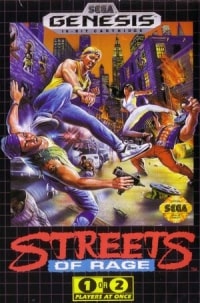
Streets of Rage is a beat 'em up game developed and published by Sega for the Genesis in 1991. Players control one of three former police officers turned vigilantes who battle a crime syndicate. Streets of Rage establishes many conventions of the Streets of Rage series, such as two-player cooperative play and an acclaimed techno soundtrack from composer Yuzo Koshiro. It was ported for the Game Gear, Sega CD and Master System and has been rereleased as part of various compilations and on download services.
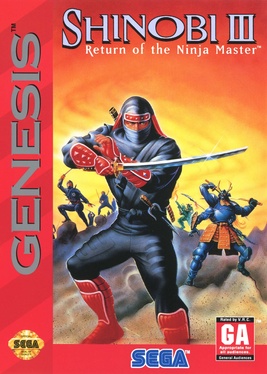
Shinobi III: Return of the Ninja Master, released in Japan as The Super Shinobi II, is a 1993 hack-and-slash platform game developed and published by Sega for the Mega Drive/Genesis. It is the direct sequel to the previous The Revenge of Shinobi. The game was intended to be released in 1992 and to be very different from the final version of the game in terms of levels and storyline. Shinobi III received critical acclaim. It's been ranked among the greatest Mega Drive/Genesis games.

Sega Classics Arcade Collection is the name of two compilations released for the Sega CD. Despite their titles, both versions of Sega Classics Arcade Collection include only the Sega Genesis ports of all the games included.

Streets of Rage 2, known as Bare Knuckle II in Japan, is a 1992 side-scrolling beat 'em up video game published by Sega for the Genesis/Mega Drive. A sequel to Streets of Rage (1991), the characters Axel Stone and Blaze Fielding return while the game also introduces two new characters: Max Thunder, and Eddie "Skate" Hunter, the younger brother of Adam Hunter from the first game.

Shinobi Legions, known as Shinobi X in Europe and as Shin Shinobi Den in Japan, is an action game in the Shinobi series developed and published by Sega in 1995 for the Sega Saturn.

Shinobi is a 3D action-adventure video game developed by Overworks and published by Sega as part of the Shinobi series. It was released for the PlayStation 2 console on November 12, 2002, in North America; December 5 in Japan; and May 15, 2003, in Europe. The game stars the master ninja Hotsuma, leader of the Oboro clan, who wields Akujiki, a sword that feeds on souls. He can also use ninja magic, shurikens, and special moves. Upon finding a golden castle after an earthquake, Hotsuma makes it his goal to defeat the powerful sorcerer Hiruko, who had summoned hellspawn creatures in Japan to destroy Tokyo. Hotsuma's mission is to stop Hiroko from destroying the world and avenge the death of his clan.

Shinobi is a series of hack-and-slash games created by Sega. The ninja (shinobi) Joe Musashi is the protagonist of the original series of games. The first Shinobi was released in 1987 as an arcade video game. Along with Alex Kidd and Sonic the Hedgehog, Joe Musashi has long been one of Sega's flagship characters, acting as a mascot for a short time in the late 1980s when ninjas were popular in mainstream media. The series' games are a showcase of Sega's technical accomplishment, noted for their high quality of graphics, gameplay and music, as well as their high level of difficulty. The Shinobi franchise sold more than 4.60 million copies.

The Cyber Shinobi is a side-scrolling hack and slash produced by Sega that was released for the Master System in 1990. It was the third Shinobi game for the console and served as a futuristic sequel to the original Shinobi. The game was released in Canada, Europe, Australia and Brazil, at a time when the Master System was discontinued in other markets.

The G.G. Shinobi (ザ・GG忍) is a side-scrolling action game by Sega released for the Game Gear in 1991. It was the first Shinobi game developed specifically for a portable game platform. The player controls the modern-day ninja Joe Musashi, protagonist of previous Shinobi games, as he goes on a mission to rescue four kidnapped comrades from an enemy, gaining control of the other ninjas as the game progresses in a manner similar to Mega Man. It was followed by The G.G. Shinobi II: The Silent Fury in 1993. The G.G. Shinobi was one of the first Game Gear games available on the 3DS Virtual Console in March 2012.
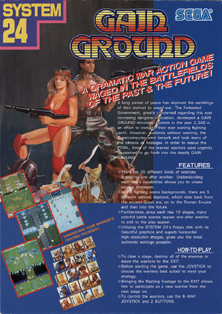
Gain Ground is an action game with strategy elements released as an arcade video game by Sega in 1988. It was ported to the Master System, Mega Drive/Genesis, and TurboGrafx-CD.
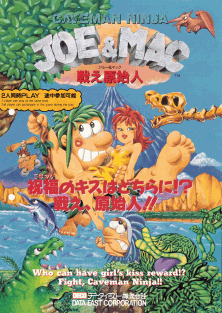
Joe & Mac, also known as Caveman Ninja and Caveman Ninja: Joe & Mac, is a run and gun platform game released as an arcade video game by Data East in 1991. It was adapted for the Super NES, Mega Drive/Genesis, Nintendo Entertainment System, Game Boy, Amiga, Zeebo, Nintendo Switch, and IBM PC compatibles.

Shadow Dancer is a side-scrolling hack-and-slash action game produced by Sega and originally released as an arcade game in 1989. It is the second and the final arcade game in the Shinobi series, following the original Shinobi itself. The player controls a ninja aided by an attack dog, who is fighting to save the city from a terrorist organization.

Shadow Dancer: The Secret of Shinobi, also known simply as Shadow Dancer, is a side-scrolling action game developed and published by Sega for the Sega Genesis in 1990. It is the second game in the Shinobi series released for the Mega Drive, following The Revenge of Shinobi. However, it is not a continuation of the previous game, but rather a loose adaptation of the 1989 arcade game Shadow Dancer. Like in the original arcade game, the player controls a ninja followed by a canine companion. The Secret of Shinobi was well received by critics.
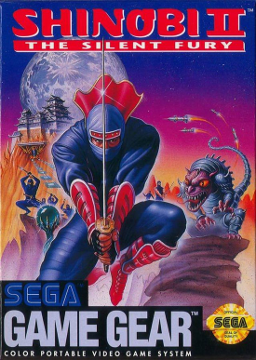
The G.G. Shinobi II: The Silent Fury is a side-scrolling action game by Sega released for the Game Gear in 1992. It is the sequel to The G.G. Shinobi, an offshoot of the Shinobi series created for Sega's portable platform. The player controls Joe Musashi as he rendezvous with his ninja allies from the previous game, giving the player access to different characters with unique abilities as the game progresses.
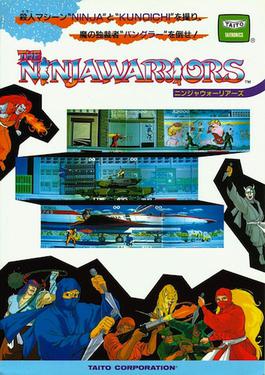
The Ninja Warriors (ニンジャウォーリアーズ) is a side-scrolling beat 'em up video game developed and released by Taito in 1987. The original arcade game situated one display in between projected images of two other displays, creating the appearance of a triple-wide screen. Ports were released for home systems including the Amiga, Atari ST, ZX Spectrum, Commodore 64, Amstrad CPC, PC Engine, and Sega Mega-CD.
Streets of Rage is a series of side-scrolling beat 'em up video games. It centers on the efforts of several ex-police vigilantes trying to eliminate the fictional American metropolis of Wood Oak City from a crime syndicate that has corrupted its local government. The first three games in the franchise were developed and released by Sega for the Sega Genesis in the early 1990s and have since been ported and re-released on various platforms. A fourth entry was also released in 2020.

Shinobi, known in Japan as Shinobi 3D, is a Nintendo 3DS video game developed by Griptonite Games and published by Sega as part of the Shinobi series, and was released worldwide in November 2011.
The Sega Zone, also known as Sega Reactor is a dedicated video game console released under license from Sega in summer 2010. It has 20 built-in classic games from the Mega Drive/Genesis library. Of these 20 games, 16 of them have motion-control enabled. When released, it cost £49 in the UK.
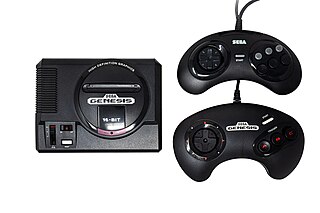
The Sega Genesis Mini, known as the Mega Drive Mini in regions outside of North America, is a dedicated console modeled on the Sega Genesis. The Mini emulates the original console's 16-bit hardware, and includes 42 games made available through emulation software by M2. It was released in North America and Japan in September 2019 and in Europe and the Middle East in October 2019. A follow-up, Sega Genesis Mini 2, was released in October 2022 and includes 60 games from the Genesis and Sega CD.


















